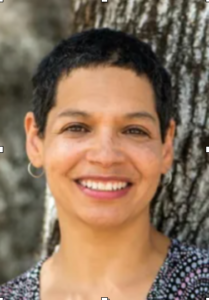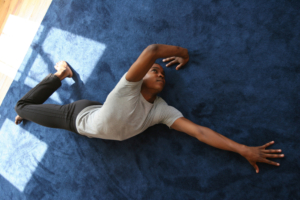A Possible Typology of Case Studies in the Feldenkrais Method

Cliff Smyth
From:
IFF Academy Feldenkrais Research Journal, 2004, volume 4 Review of types of Feldenkrais Method case studies and value of case appraoch for studying the practice of the Feldenkrais Method.
www.iffresearchjournal.org/volume/4/smyth
You can read the paper here:
Cliff Smyth is a faculty member in the Department of Mind-Body Medicine in the College of Integrative Medicine and Health Sciences, Saybrook University, and an adjunct lecturer at San Francisco State University teaching somatics. He teaches Feldenkrais Method and does health and wellness coaching at the Feldenkrais Center for Movement and Awareness in San Francisco. Cliff does research in movement, somatics, bodily awareness, health, and well-being. His dissertation was on the Lived Experience of the Feldenkrais Method. He is working on writing about the methodology (hermeneutic phenomenology) and results (the bodily experience of fluidity, ease, integration, and well-being), as well as collaborating on projects on body awareness and embodied cognition. He is the editor of the Feldenkrais Research Journal.
Quoting from the paper:
Why case studies?
Case studies are used in a great variety of fields and reflect a wide range of research methods, styles of reports, purposes, etc. A case study can be described as a study of a single system, person, event, program, etc. They may include qualitative, quantitative or a mix of different kinds of data. Moshe Feldenkrais was familiar with and often referred to thinkers who make powerful use of case studies and histories (including A.R. Luria, Konrad Lorenz, Sigmund Freud,
Charles Darwin, Jean Piaget, Milton Erikson, amongst others). He used ‘teaching stories’ extensively in his writing and in the tr aining programs he conducted in San Francisco and Amherst. The wonderful and informative book The Case of Nora (Feldenkrais, 1977) was just the first of a series of case studies he had planned.
Interestingly the early volumes of the Feldenkrais Guild of North America’s Journal of the Feldenkrais Method featured many case studies. A few of these were also included in the IFF Journal, which published two volumes completely composed of case studies. Perhaps it is understandable, in those early days of practitioners (other than Feldenkrais himself) writing about the method, that they chose the narrative case study as an accessible form.
As a professional community it would seem that we still place value on case studies, and to some extent support a culture of writing case studies. This may be reflected in the fact that case studies are part of the requirements for advancement to become a teacher of Feldenkrais teachers
Observation and documentation are fundamental to the development of any practice, including science. The natural sciences are based on hundreds – or thousands – of years of naturalistic observation before the development of the repeatable studies, sophisticated instrumentation and the formulation of the laws we associate with the ‘hard’ sciences. It is hardly surprising that the typical narrative case study, with its emphasis on observation and description, was a common form in the early days of our reflection on the new kinds of human knowledge generated by the practice of the Feldenkrais Method.
From the notes
…
References:
Cliff Smyth writes: “In preparation for this presentation and article I read all the published case studies from all editions of the Journal of the Feldenkrais Method and the IFF Journal up to 2004. Other references include:
Aldridge, David, ‘Single Case Research Design for the Clinician’, Complementary Medical Research, 1988; 3 (1), pp.37-46. (Available at: www.musictherapyworld.net/modules/archive/papers/list_all.php?orderby=title ).
Beringer, Elizabeth, ‘Self Imaging’, The Feldenkrais Journal, No. 13, 2001, pp. 33-38, Feldenkrais Guild of North America.
Beringer, Elizabeth, ‘Feldenkrais: Introduction’ and ‘Heather’, pp. 8 1-99 in Hanlon Johenson, Don (ed.), Groundworks: Narratives of Embodiment, North Atlantic Books, Berkeley, California/California Institute of Integral Studies, San Francisco, California, 1997
Emerson, Robert M., Fretz, Rachel I., and Shaw, Linda L, Writing Ethnographic Field Notes,University of Chicago Press, Chicago and London , 1995.
Epstein, Julia, Altered Conditions: Disease, Medicine and Storytelling, Routledge, New York andLondon, 1995.
Feldenkrais, Moshe, The Case of Nora: Body-Awareness as Healing Therapy, Harper and Row,New York, 1977.
Fogel , Alan, ‘Documenting Cases as a Participant Observer: A Manual for Somatic AwarenessPractitioners’,
Feldenkrais Research Journal, Vol. 3, 2006-2007, IFF Academy, InternationalFeldenkrais Federation.
Geertz, Clifford, The Interpretation of Cultures: Selected Essays, Basic Books, NY, 1973 (See: ‘Part1: Thick Description: Toward an Interpretive Theory of Culture’).
Ginsburg, Carl, ‘The Roots of Functional Integration, Part 1’, The Feldenkrais Journal, No. 3, 1987,pp.13-22, ‘The Roots of Functional Integration, Part 2’, The Feldenkrais Journal , No. 4, 1988, ‘The Roots of Functional Integration, Part 3’, The Feldenkrais Journal, No. 7, 1992, pp. 34-47,Feldenkrais Guild of North America.
Jarvis, Peter, The Practitioner-Researcher: Developing Theory from Practice, Jossey-Bass, SanFrancisco, 1999
Johnson, Don Hanlon (ed), ‘Body Making’, pp. 1
-13, Groundworks: Narratives of Embodiment,North Atlantic Books, Berkeley, California/California Institute of Integral Studies, San Francisco,California, 1997.
Johnson, Don Hanlon, ‘Body Practices and Human Inquiry: Disciplined Experiencing, FreshThinking, Vigorous Language’, Chapter in: Berdayes, Vinc
ent, Esposito, Luigi and Murphy, JohnW., (eds), Body in Human Inquiry: Interdisciplinary Explorations of Embodiment, HamptonPress, 2004. (Available at: www.donhanlonjohnson.com).
Joly, Yvan, ‘The Experience of Being Embodied: Qualitative Research and Somatic Education: A perspective based on the Feldenkrais Method’,
Feldenkrais Research Journal, No.1, 2004, IFFAcademy, International Feldenkrais Federation.
Kazdin, Alan E., Single Case Research Designs: Methods for clinical and applied settings, OxfordUniversity Press, New York, 1982.
Merriam, Sharan B., Qualitative Research and Case Study Applications in Education (revised andexpanded from Case Study Research in Education), Jossey-Bass, San Francisco, 1998.
Barbara Pieper, ‘I Zu Dritt in Erwartung Erzählte und reflektierte Praxis alsEntwicklungsprozess’,
Feldenkrais Research Journal, No. 4, 2009, IFF Academy, InternationalFeldenkrais Federation. (Read by the author in an English translation.)
IFF Academy Feldenkrais Research Journal volume 4www.iffresearchjournal.org/volume/4/smyth
Ramachandran, V.S. and Blackslee, Sandra, Phantoms in the Brain, William Morrow and Co, NY,1998 (See: Preface, pp. xi-xvii)
.Reason, Peter (ed), Human Inquiry in Action: Developments in New Paradigm Research, SagePublications, London, 1998.
Reason, Peter and Rowan, John (eds), Human Inquiry: A Sourcebook of New Paradigm Research, John Wiley and Sons, Chichester & New York, 1981.
Rywerant, Yochanon, The Feldenkrais Method: Teaching by Handling, Keats Publishing, NewCanaan, Connecticut, 1983.
Sacks, Oliver, An Anthropologist on Mars, Vintage/Random House, NY, 1995 (See: Preface, pp.xv-xx).
Schön, Donald A., The Reflective Practitioner: How Professionals Think in Action, Basic Books, New York, 1983.
Stephens, James, Call, Susannah, Evans, Kristin, Glass, Melissa, Gould, Cathy and Lowe, Jennifer,
‘Responses to Ten Feldenkrais Awareness Through Movement Lessons by Four Women with Multiple Sclerosis: Improved Quality of Life, ‘
Physical Therapy Case Reports, Volume 2, No. 2,March 1999, pp 58-69.
.Yin, Robert K, Case Study Research: Design and Methods, Sage Publications, Thousand Oaks,California, 1994.
Zucker, Donna M., ‘Using Case Study Methodology in Nursing Research’,
The Qualitative Report, Volume 6, Number 2, June 2001. (Available at: www.nova.edu/sss/QR/QR6-2/zucker.html).







